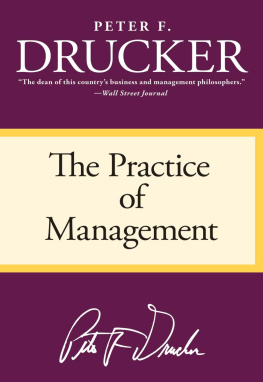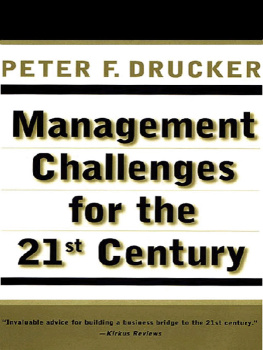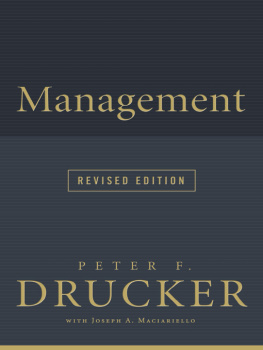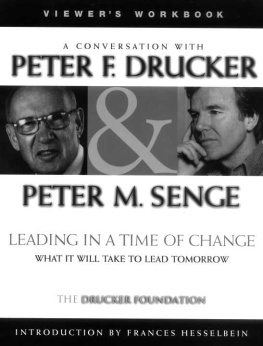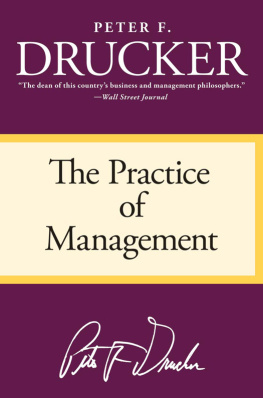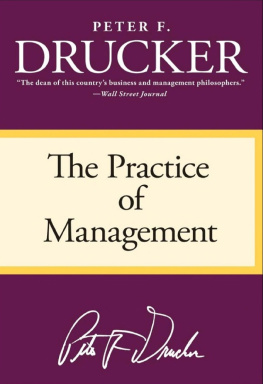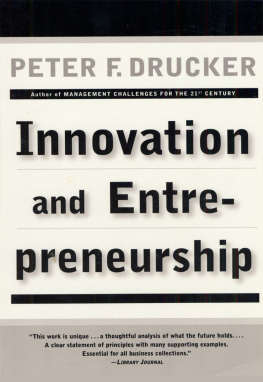Drucker - The Practice of Management
Here you can read online Drucker - The Practice of Management full text of the book (entire story) in english for free. Download pdf and epub, get meaning, cover and reviews about this ebook. City: New York;United States, year: 1993;1954, publisher: HarperCollins;HarperBusiness, genre: Politics. Description of the work, (preface) as well as reviews are available. Best literature library LitArk.com created for fans of good reading and offers a wide selection of genres:
Romance novel
Science fiction
Adventure
Detective
Science
History
Home and family
Prose
Art
Politics
Computer
Non-fiction
Religion
Business
Children
Humor
Choose a favorite category and find really read worthwhile books. Enjoy immersion in the world of imagination, feel the emotions of the characters or learn something new for yourself, make an fascinating discovery.
- Book:The Practice of Management
- Author:
- Publisher:HarperCollins;HarperBusiness
- Genre:
- Year:1993;1954
- City:New York;United States
- Rating:5 / 5
- Favourites:Add to favourites
- Your mark:
- 100
- 1
- 2
- 3
- 4
- 5
The Practice of Management: summary, description and annotation
We offer to read an annotation, description, summary or preface (depends on what the author of the book "The Practice of Management" wrote himself). If you haven't found the necessary information about the book — write in the comments, we will try to find it.
Drucker: author's other books
Who wrote The Practice of Management? Find out the surname, the name of the author of the book and a list of all author's works by series.
The Practice of Management — read online for free the complete book (whole text) full work
Below is the text of the book, divided by pages. System saving the place of the last page read, allows you to conveniently read the book "The Practice of Management" online for free, without having to search again every time where you left off. Put a bookmark, and you can go to the page where you finished reading at any time.
Font size:
Interval:
Bookmark:
Management books, though only few of them, had been written and published before The Practice of Management appeared in 1954. I myself had published in 1946 my first management book, Concept of the Corporation (New York: John Day). A few years earlier, in 1938, Chester I. Barnards The Functions of the Executive (Cambridge, Mass.: Harvard University Press) had appeared. The papers on management Mary Parker Follett had written in the 1920s and early 1930s were collected and published under the title Dynamic Administration (New York: Harper & Brothers) in 1941. Elton Mayo, the Australian-born Harvard professor, had published his two short books on work and worker: The Human Problems of an Industrial Civilization (New York: Macmillan) and The Social Problems of an Industrial Civilization (Cambridge, Mass.: Harvard University Press) in 1933 and 1945, respectively. The English translation of Henry Fayols Industrial and General Administration first published in Paris in 1916had come out in 1930 (London, England: Pitman); and Frederick W. Taylors Scientific Management had come out even earlier, in 1911 (New York: Harper & Brothers), and had been reprinted many times since.
Every one of these books is still being read widely, and deserves to be read widely. Every one was a major achievement. Every one laid firm and lasting foundations; indeed, in their respective fields, none has yet been surpassed. There are no better guides to what we now call organizational psychology and organizational development than Barnard and Mary Parker Follett. When we talk of quality circles and worker involvement, we only echo what Elton Mayo wrote forty and fifty years ago. Fayols language is outdated, but his insights into the work of management and its organization are still fresh and original. Little has been added in respect to top management, its functions and its policies to what I wrote in Concept of the Corporation . And we find ourselves today going back to Taylor in order to understand the work of knowledge-workers and to learn how to make knowledge-work productive.
Still, The Practice of Management was the first true management book. It was the first to look at management as a whole, the first that attempted to depict management as a distinct function, managing as specific work, and being a manager as a distinct responsibility. All earlier books had dealt with one aspect of management and managingwith communications, for instance, as did Barnards Functions of the Executive , or with top management, organizational structure, and corporate policy, as did my Concept of the Corporation. The Practice of Management talks of managing a business, managing managers, and the management of worker and workthe titles, respectively, of Parts One, Two, and Four. It talks of the structure of management (Part Three) but also of making decisions (Chapter 28). It talks of the nature of management, its role, its jobs, and the challenges managements face. But it also talks of managers as people, of the individual men and women who perform managerial work and hold managerial positions: their qualifications, their development, their responsibilities, their values. The Practice of Management has a chapter entitled The Spirit of an Organization (Chapter 13), in which can be found everything that is now discussed under the heading of corporate culture. The Practice of Management was the first book to talk of objectives, to define key result areas, to outline how to set objectives, and to describe how to use them to direct and steer a business and to measure its performance. Indeed The Practice of Management probably invented the term objectivesat least, it is not to be found in the earlier literature. And The Practice of Management was the first book to discuss both managing the existing business and innovating the business of tomorrow.
Perhaps even more importantand certainly more novelwas the fact that The Practice of Management was a first also in that it saw the enterprise as a whole. All earlier management booksand indeed most management books even nowonly see one aspect. Indeed, they usually see only the internal dimension: organization, policies, human relations within the organization, authority within it, and so on. The Practice of Management portrays the enterprise three-dimensionally: first, as a business that is an institution existing to produce economic results outside of it, in the market and for customers; second, as a human and social organization which employs people, has to develop them, has to pay them, has to organize them for productivity, and therefore requires governance, embodies values and creates relationships of power and responsibility; and third, as a social institution embedded in society and community and thus affected by the public interest. The Practice of Management also discusses the social responsibilities of businessa term that was practically unknown at the time the book was published.
The Practice of Management thus created some thirty years ago what we now refer to as the discipline of management. And this was neither accident nor good luckit was the books mission and intent.
When I wrote The Practice of Management , I had ten years successful consulting practice under my belt. My own starting point had been neither business nor management. To be sure, I had, much earlier, worked for banksone short year in Germany, three years in England. But I had become a writer and journalist and taught government and political science. I thus came to management almost by accident. In 1942 I published a book, Future of Industrial Man , in which I argued that a good many of the social tasks which community and family had performed in earlier societies had come to be discharged by organizations and especially by the business enterprise. This book attracted the attention of a senior executive of the worlds largest manufacturing company, General Motors, who, in the late fall of 1943, invited me to make an in-depth study of his top management, its structure and its basic policies. Out of this study grew Concept of the Corporation , finished in 1945 and published in 1946.
I found the work fascinatingbut also frustrating. There was practically nothing to help me prepare myself for it. Worse, what few books on management and business enterprise existed were totally inadequate. They dealt with one aspect, and one aspect only, as if it existed in isolation. They reminded me of a book on human anatomy that would discuss one joint in the bodythe elbow, for instancewithout even mentioning the arm, let alone the skeleton and musculature. Worse still, there were no studies at all on most aspects of management. Yet what made management and the work of the manager so interesting, I thought, was precisely that there was always a true whole, a three-dimensional entity. Managing, I soon learned, always had to take into account the results and performance for the sake of which the business exists, the internal organization of people engaged in a common task and the outside social dimensionthe dimension of social impacts and social responsibilities. Yet nothing could be found on most of these topics, let alone on their relationship to one another. Plenty of books existed at the time on the impact of government policy on business; indeed, courses on government regulation of business were thenand still arehighly popular. But what about the impact of business on society and community? There was ample material on corporate financebut virtually nothing on business policy and so on.
I continued for some time as a consultant to General Motors after I had finished my study. And then I gradually was called in to consult by some other large corporationsSears, Roebuck, the Chesapeake & Ohio Railroad, General Electric. Everywhere I found the same situation: a near-total absence of study, thought and knowledge regarding the job, function and challenges of managementnothing but fragments and specialized monographs. And so I decided to sit down, first to map out that dark continent, management, then to define what pieces were missing and had to be forged and finally to put the whole together into one systematic, organizedyet shortbook. In my consulting assignments I was meeting large numbers of able younger people, people in middle-and upper-middle management positions or in their first major assignment, either as a manager or as an individual professional contributor. These were the people who knew that they were managerstheir predecessors, who had made their careers before World War II, were often barely conscious of that fact. These younger achieving people knew that they needed systematic knowledge; needed concepts, principles, toolsand had none. It was for them that I wrote the book. And it was that generation which made the book an immediate success, that generation which converted being a manager from being a rank into work, function and responsibility. And the book was an immediate success, not only in the United States but worldwide, in Europe, in Latin America and, especially, in Japan. Indeed, the Japanese consider it the foundation of their economic success and industrial performance.
Font size:
Interval:
Bookmark:
Similar books «The Practice of Management»
Look at similar books to The Practice of Management. We have selected literature similar in name and meaning in the hope of providing readers with more options to find new, interesting, not yet read works.
Discussion, reviews of the book The Practice of Management and just readers' own opinions. Leave your comments, write what you think about the work, its meaning or the main characters. Specify what exactly you liked and what you didn't like, and why you think so.

